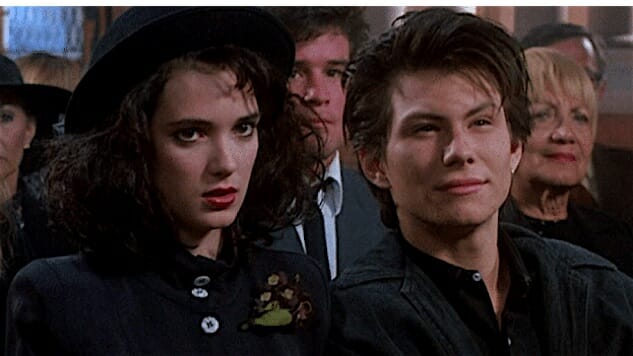Que Sera, Sera: Introducing a Teen to the Teen Canon of the 1980s
Part 5: Heathers
Movies Features Heathers
I was still chewing on what Grace had said, about the 1980s being “the last optimistic decade.” That really got under my skin, largely because it troubled me to imagine she might be right. I thought maybe we’d veered too far into the land of John Hughes, where plucky working-class kids triumphed over Teen Stuff and got to smooch in the last frame or two while a heartstring-yanking pop-music masterpiece swelled in the background. Maybe I was misrepresenting something. We needed more of what I had actually experienced as a teenager, an ’80s where there was less heartfelt Dad-hugging and triumph over minor adversity, and more likelihood of ambiguous endings. Or explosions. Or ambiguous explosions.
Cue Heathers.
Michael Lehman’s dark comedy about high school cliques comes from a … well, a different psychological terrain than the Hughes canon. It’s mannered. It’s got a certain highly stylized visual sensibility where Molly Ringwald would’ve looked all wrong and where the late and exceedingly great Harry Dean Stanton would have been kicked off the croquet lawn by security. It has a kind of chiaroscuro, where the brightness is disorienting and the darkness is what illuminates things. Until it doesn’t.
Heathers has never really been relegated to the cultural limbic brain: It was adapted into a musical in 2010 and has been a slow-to-launch TV series for years. (A trailer finally appeared just a few weeks ago after much speculation, delay and network-hopping.) So it also has less of, or at least a really different kind of, nostalgia factor than, say Pretty in Pink. So Grace had heard of it, and she was up for a trip to the darker side.
“Yeah,” she remarked through a mouthful of popcorn as the Uberpreppy Bitchmonsters strolled across the lawn to the strains of “Que Sera, Sera.” I guess it can’t always be Ferris Bueller’s day off.”
“It really can’t,” I said.
Like most “teen movies,” Heathers is a film about the adolescent struggle to balance two strong and opposing drives: Individuation and conformity. Whereas John Hughes protagonists are generally underdogs, Heathers has a protagonist who is only an underdog in the context of the most powerful and feared clique of trendsetting mean girls in her high school. To everyone else, Veronica Sawyer (Winona Ryder) isn’t particularly suffering. So the question: in an era where the Heathers are all named Madison, would this film still pack a punch? And would it show Grace another element of 1980s pop culture that maybe wasn’t so “optimistic?”
Enter Christian Slater in his breakthrough role as Jason Dean, a charming psychopath who really takes it seriously when you say you wish your conniving, bullying friend would “puke her guts out.”
“Whoa,” Grace said, as JD began to fly his really, really violent freak flag more openly. Then: “Whoa!” and “Holy crap, seriously?”
Yes, as it turns out, bullying, when it gets at all serious, can still be shocking, and when the film’s character-driven and not a bunch of CG space-battles and the bullets kill real people, it’s profoundly disorienting, especially in a film you’ve been led to believe is a comedy. Watching Veronica turn to JD out of frustration and disgust with the power dynamics of her nasty in-crowd only to find she’s fallen for something even scarier than a bunch of socially influential teenage girls? Still hilarious and horrifying at once.
“So,” Grace said, “first of all, Yellow Heather is the best Heather.”
“Why?”
“She’s not actually cruel. At least not to Veronica. I’m glad she doesn’t die.”
“Do you think the film is funny?” I asked. “Or rather, do you think it’s a comedy?”
Grace smiled. “It’s an anti-comedy.”
“You mean a black comedy?”
“No. An anti-comedy.”
“What makes it an anti-comedy?”
Grace gave me what was probably an earned dose of teen side-eye. “It sets up the expectations of something that’ll be funny but it’s not freakin’ funny? Which is funny?”
Touché?
“So do you like it?”
“JD is really disturbing.”
There was no point to asking “How so?”
I try not to mindread, but I found myself thinking back into my own teen years and some of the feral males who tailed me around Berkeley when I was the age she is now. Any one of them could have been that kid, the cute, charismatic guy you have to literally detonate before he destroys you. Literally manipulating a lemming-like teen population into believing the trendy new thing is suicide? And getting more and more crazy as every single humiliating and hideous death backfired on him, turning mean-spirited, superficial people into wells of secret depth, ennobled by pain; turning moronic bullies into tragic heroes? OK, that was a trope, sure. But it was disturbing, in retrospect, to realize how close that metaphor came to … not-metaphor. Not just because it’s really freaking insane how far kids will go to fit in, and how far they will go to disambiguate. But I also remembered with a certain amount of shock that Grace had never lived in a world where Columbine hadn’t happened. The Sandy Hook mass-casualty shooting took place the same week as her tenth birthday. There have always been incidents of violence in schools, but not like that. For her generation, the idea of a homicidal high school kid is both more normal and more frightening.
“It’s brilliant,” she added. “And it’s funny. But yeah, disturbing.”
Amy Glynn was not a Heather.